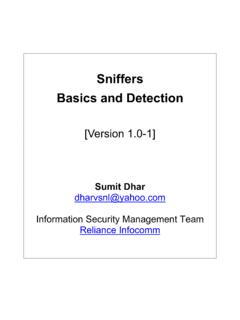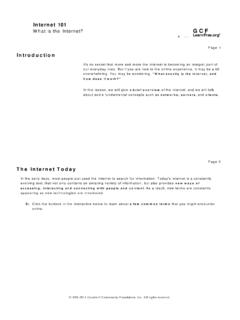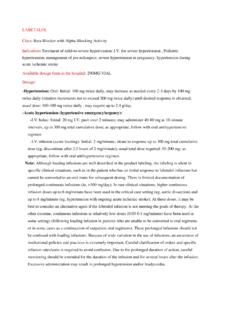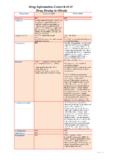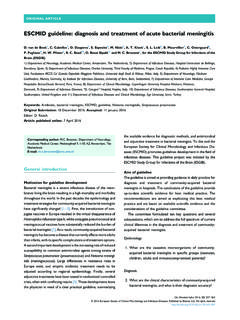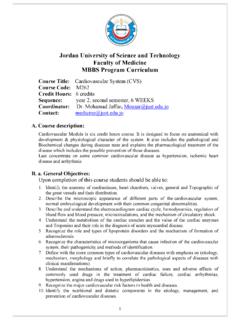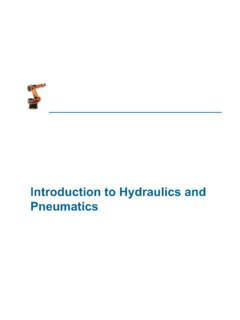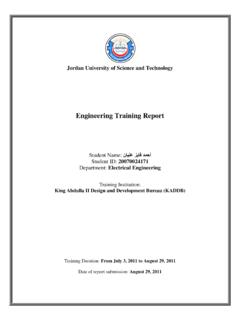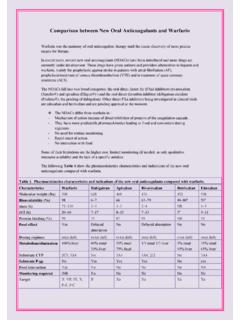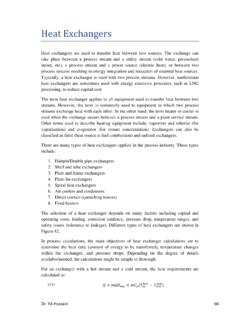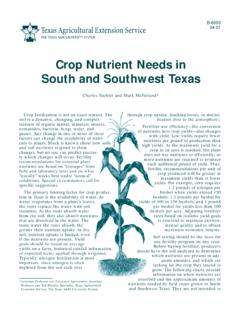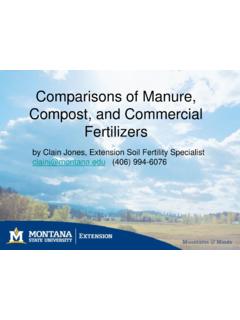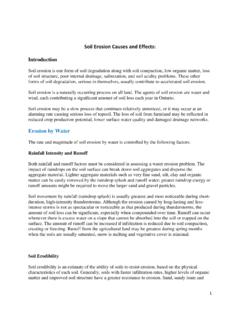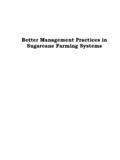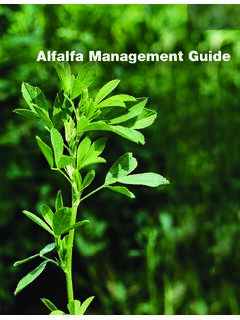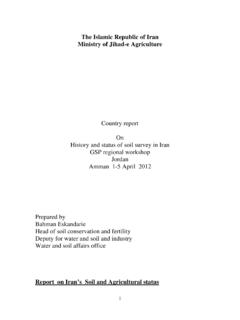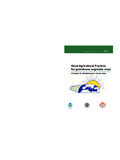Transcription of Jordan University of Science and Technology
1 Jordan University of Science and Technology Faculty of Agriculture Department of Natural Resources and Environment First Semester 2006/2007 Course Information Course Title soil fertility AND FERTILIZERS Course Number (NR 412) (Line #: 644120) Prerequisites NR 202 & PP 205 Course Website Instructor Prof. Munir Rusan Office Location Office Phone 22200 Office Hours Mon & Wed 11:00 12:00 OR by appointment E-mail Teaching Assistant Course Description NR 412: soil fertility and Fertilizers (3C, 3H) soil chemical and physical properties as related to soil fertility . Plant nutrients and their classification, functions, soil and plant contents, reactions and availability in the soil . Movement and absorption of plant nutrients. Fertilizers classification, types and application methods. soil fertility evaluation and fertilizer recommendations. Fertigation and advanced techniques in fertilizer applications.
2 (Prerequisite: NR 202, PP 205) Text Book Title soil fertility and Fertilizers, An introduction to Nutrient Management Author(s) Havlin, ; Beaton, ; Tisdale, ; and Nelson, Publisher Prentice Hall, New Jersey; Year 1999 Edition 6th Edition Book Website - References Text Book Title soil fertility and Fertilizers Author(s) Tisdale, S. L., Nelson, and Beaton Publisher Macmillan Publishing Co., N. Y. 1993 Year 1993 Edition 5th Edition Book Website References Assessment Policy Assessment Type Expected Due Date Weight First Exam 25% Second Exam 25% Final Exam 40% Assignments 10% Course Objectives Weights To develop an understanding of the: 1.
3 soil fertility and productivity, role of soil in supplying nutrients to plants, growth factors 10% 2. Major soil -plant relationships and their influence on the main soil functions and phenomena that affect soil fertility parameters 15% 3. Mineral nutrients: requirements, classification forms and functions in the plants 15% 4. Fertilizers of the major macronutrients and micronutrients: sources, forms, reactions in the soil , environmental concerns 30% 5. Development, characterization and management of acid soils and salt affected soils 10% 6. Types, and methods of fertilizer application: techniques, advantages and disadvantages 10% 7. soil fertility evaluation, fertilizer recommendation 10% Teaching & Learning Methods Lecture notes will be presented in: 1. Power point presentation 2. Handouts 3. Field trips Learning Outcomes: Upon successful completion of this course, students will be able to Related Objective(s) Reference(s) Objective 1 1.
4 How to distinguish between soil fertility and soil productivity and how to manage or control factors affecting both fertility and productivity of the soil 1. soil fertility and Fertilizers, An introduction to Nutrient Management. By Havlin, ; Beaton, ; Tisdale, ; and Nelson, Prentice Hall, New Jersey; 1999, 6th edition 2. Handouts Objective 2 2. soil physical and chemical properties that affect availability of nutrients in the soil , and learn how to consider these properties for optimizing fertilizer management 1. soil fertility and Fertilizers, An introduction to Nutrient Management. By Havlin, ; Beaton, ; Tisdale, ; and Nelson, Prentice Hall, New Jersey; 1999, 6th edition 2. Handouts Objective 3 3. Classification of nutrients based on various categories according to the objectives of the classification. Beside, they will learn terminology related to status of the nutrients in the plant tissues.
5 1. soil fertility and Fertilizers, An introduction to Nutrient Management. By Havlin, ; Beaton, ; Tisdale, ; and Nelson, Prentice Hall, New Jersey; 1999, 6th edition 2. Handouts Objective 4 3. Nature, behavior and availability of the native nutrients in the soil ; how they interact with agricultural crops; how to consider these data to make the right decision on which nutrients should be added. 1. soil fertility and Fertilizers, An introduction to Nutrient Management. By Havlin, ; Beaton, ; Tisdale, ; and Nelson, Prentice Hall, New Jersey; 1999, 6th edition 2. Handouts Objective 5 4. How to manage and/or reclaim acid soils and salt affected soils (both saline and sodic soils). How to optimize both crop and soil management to successfully use these types of soil without further degradation of the soil 1. soil fertility and Fertilizers, An introduction to Nutrient Management.
6 By Havlin, ; Beaton, ; Tisdale, ; and Nelson, Prentice Hall, New Jersey; 1999, 6th edition 2. Handouts Objective 6 5. Learn how to evaluate soil fertility based on visual observations, soil chemical testing and plant tissue analyses. How to make representative samples and how to prepare them for analysis and make fertilizer recommendations based on the results of the analysis 1. soil fertility and Fertilizers, An introduction to Nutrient Management. By Havlin, ; Beaton, ; Tisdale, ; and Nelson, Prentice Hall, New Jersey; 1999, 6th edition 2. Handouts Objective 7 3. Learn about the most popular methods of fertilizer application; 1. soil fertility and Fertilizers, An introduction to Nutrient when, where to place and how to implement each method. They will also learn how to select the best type, form of fertilizers for various soil and crop conditions Management. By Havlin, ; Beaton, ; Tisdale, ; and Nelson, Prentice Hall, New Jersey; 1999, 6th edition 2.
7 Handouts Useful Resources Text book Lecture notes Handouts Course Content Week Topics Chapter in Text (handouts) 1 Introduction: soil fertility ; soil productivity Chapter 1 and Handouts 2 Growth and the factors affecting it: Factors affecting plant growth; Growth expressions Chapter 1 and Handouts 3 Plant nutrients: Essentiality and classification of plant nutrients; Definitions (deficient, insufficient, excessive, toxic, competition, antagonism, synergism) Chapter 1 and Handouts 4 & 5 Basic soil - plant relationships: Anion and cation exchange; Contact exchange; Root cation exchange Chapter 1 and Handouts 6 & 7 Movement of ions from soils to roots: Mechanisms; cell membrane and ion absorption mechanisms by roots Chapter 1 and Handouts 8 & 9 soil and nitrogen fertilizers: N cycle; soil N; Plant N; N fertilizers; Environmental concern Chapter 1 and Handouts 10 soil and phosphorus fertilizers: P cycle; soil P; Plant P; P fertilizers; Environmental concern Chapter 1 and Handouts 11 soil and potassium and sulfur: soil K and S; Plant K and S; K and S fertilizers; Chapter 1 and Handouts 12 & 13 soil and micronutrients: soil and plant contents; Fertilizers micronutrients Chapter 1 and Handouts 14 Salt-affected soils: Origin and sources of soil salinity; Classification; reclamation and management Chapter 1 and Handouts 15 & 16 Fundamental of fertilizer application: Methods of application; Advanced techniques of fertilizer application fertigation Chapter 1 and Handouts Additional Notes Assignments Expected due date Exams Exams will be hold on time as scheduled unless the University is off.
8 Makeup exam is allowed only under very serious situation and the makeup exam will be given by two instructors and in two parts (written and oral). The makeup exam is always more challenging Cheating Cheating will be reported to the department Chair for further processes. Penalties vary from getting zero in the exam to dismissing for a semester or more Attendance Attendance of the lectures is obligatory (15% is max. allowable absence starting from lecture #1) Workload Attendance, preparation, assignments, exams, Graded Exams Graded exams will be given back to the students Participation Participation is encouraged Laboratory The lab is separate course Projects Term papers
